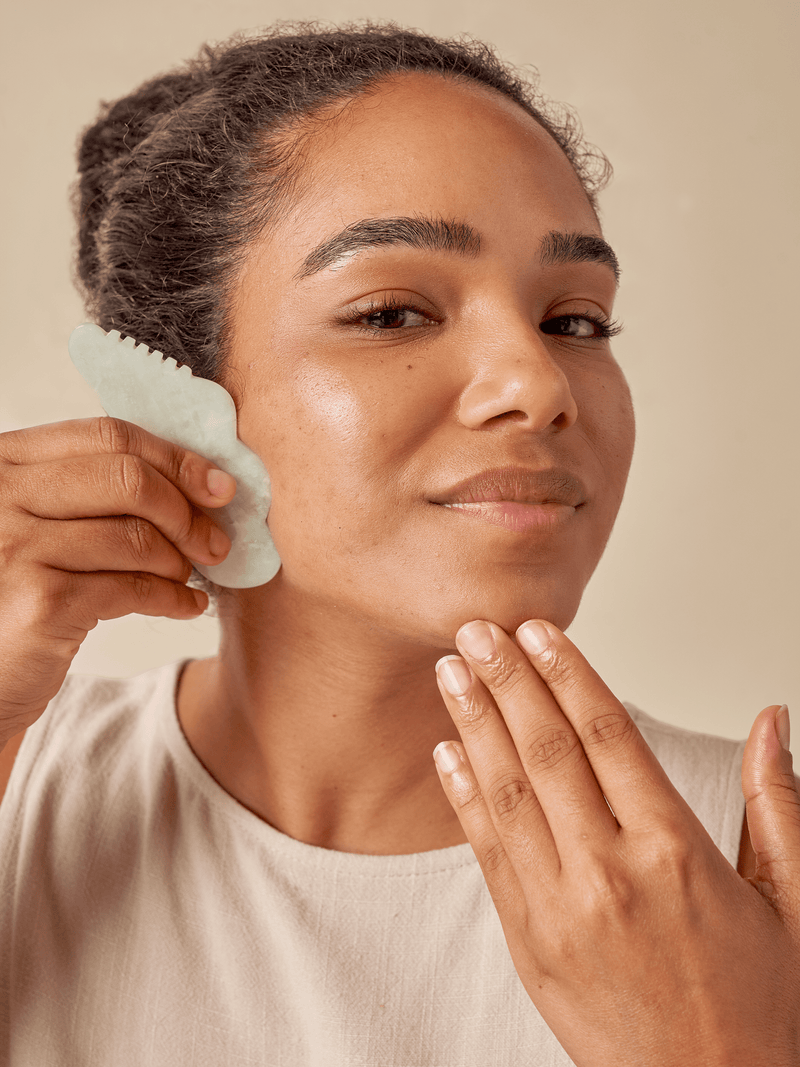What’s Your Infradian Rhythm? It Might Be the Key to a Happier + Balanced You
If you’re familiar with the health and wellness world, you’ve heard of your circadian rhythm (aka your internal biological clock).
But you might not know that women have a second biological rhythm. It’s arguably just as important, yet left untouched by many medical professionals.
The infradian rhythm is a (roughly) 28-day cycle that accompanies female physiology. This influences your body’s health as it fluctuates with your hormonal cycles each month.
Regimens like morning routines and regular workouts can be beneficial for hormonal health. But there’s often one crucial component missing: your unique infradian rhythm.
→ Ever felt more social at certain times of the month and completely drained at other times?
There’s a reason for that, and it’s tied to your infradian rhythm.
→ Ever forced yourself into a workout while feeling tired during your period?
Infradian rhythms explain why forcing yourself into extreme activity during your period may not support your body in the best way possible.
Let’s pull back the covers on this fascinating biological clock. It can help you live a healthier, less stressful, and more productive life.
The Infradian Rhythm Explained
It's possible to optimize your body + mind throughout your hormonal cycles. But first, you’ll want to understand how the infradian rhythm is tied to your cycles.
Infradian rhythms are biological clocks that exist to keep our bodies functioning optimally. As humans, we all have biological clocks, and so do animals. They’re natural. We don’t have to do anything to “activate them” – they work in the background every day. The Cleveland Clinic points out that infradian rhythms exist everywhere, in different forms:1
The circadian rhythm and infradian rhythm play different roles. But they still interact with + depend on each other. Your circadian rhythm functions on a 24-hour cycle. Meanwhile, the infradian rhythm is linked to a woman’s hormonal cycle which is (roughly) 28 days long.
Alisa Vitti is a functional nutritionist and women’s hormonal expert. She’s spent years researching and closely studying the infradian rhythm and hormonal cycles in females. Her discovery? It’s key to optimizing women’s health in a realistic, results-oriented way. As she points out, the infradian rhythm governs six crucial systems in your body:2
- Brain
- Metabolism
- Immune system
- Microbiome
- Stress response system
- Reproductive system
Sounds pretty significant, right? It is. So why doesn’t it get the recognition it deserves?
Why You Haven’t Heard of Infradian Rhythms Before
The science of infradian rhythms deserves a place in the medical world. So why don't we hear about it? We loved Alisa’s simple explanation that shows the real root of the issue:3
“When putting together clinical trials, many researchers have decided it is simply too complicated to include women as subjects because our monthly hormone cycle is too complicated.”
This is just a small preview of how women’s health is often overlooked in the western healthcare system. Many body-building systems, plans, and diets pushed on women are based on men’s health – because it’s easier to navigate.
Wait, what?!
Alisa is bringing justice through her work. She fights for the unique biological rhythms (and needs) of females. And as she points out, it also explains some of the upticks in hormonal and autoimmune issues among women. Because following regimens based on the circadian rhythm alone isn’t enough.3
She’s dedicated years to developing and perfecting the Cycle Syncing Method.Ⓡ Her method shows women how to achieve optimal health through nutrition, exercise, and routines geared toward the unique changes within your infradian rhythm.
Here’s how the infradian rhythm is linked to your hormonal cycles each month.
Factors That Affect Your Infradian Rhythm and Hormonal Cycles
Here are the biggest factors that disrupt your infradian rhythm and hormonal cycles.
- Extreme exercise or being underweight: Both force your metabolism to adjust and preserve energy for other more “critical” bodily functions.1 It’s like why your vagus nerve hops into energy preservation mode – or why autophagy works well as a detox.
- Overweight/excess body fat: The same is true on the opposite end of the scale! Too much body fat can increase estrogen levels and disrupt your hormone balance, leading to hormonal issues.1
- Birth control: Most hormonal contraceptives significantly alter the hormones in your hormonal cycle. These changes can lead to a cascade of untold physical, mental, and emotional side effects.3
- Medical conditions like PCOS: Unfortunately, undiagnosed conditions like PCOS can affect your infradian rhythm behind the scenes. And it can lead to a variety of confusing + mysterious symptoms that are hard to resolve. (Check out this resource for more information on PCOS)
- Stress: Stress creates a “fight or flight” response that increases cortisol levels. Left unchecked, it can delay, interfere with, or stop menstruation.
- An “off” circadian rhythm: Irregular patterns in your circadian rhythm can also affect your infradian rhythm. Periods of less sleep or jet lag can throw off the circadian rhythm, which also skews hormone levels.4
With this knowledge, what can you do to support your infradian rhythm? You can optimize your personal/external rhythms to tune into your body’s natural ebbs and flows.
Let’s start with your hormonal cycles, which are controlled by your infradian rhythm.
How to Support Infradian Rhythms In Your Hormonal Cycles
Infradian rhythms regulate your hormonal cycles by suppressing or increasing hormones in each phase. So one of the best ways to get more in touch with your infradian rhythm is to understand your menstrual cycle.
Let’s learn more about each phase in your hormonal cycle, plus how to support the infradian rhythm.
Menstrual (Menses) – Days 1-5
This is your time of bleeding, which comes from the shedding of the endometrium lining in your uterus. Obviously, it only occurs if you’re not pregnant.
Your infradian rhythm triggers low levels of estrogen and progesterone during this time. These two hormones are associated with lower levels of serotonin too, which impact:5
→ Mood
→ Sleeping
→ Eating
→ Digestion
You can combat low serotonin with practices that complement your body’s unique needs. Here’s how to support your infradian rhythm in the menstrual phase:
- Avoid stress where you can, and practice stress-relieving techniques.
- Avoid inflammatory foods like seed oil that contribute to inflammation and anxiety.
- Take it easy with exercise – be kind to yourself! Gentle yoga or walking is ideal.
- Be mindful of sleep. Studies show a decrease in sleep quality during this phase.6 So pay attention to sleep hygiene, avoid blue light at night, and try relaxing rituals.
- Eat lots of mineral-rich, nutrient-dense warming foods (warm soups, stews, and broths + seafood and pasture-raised meats)7 (Credit: Hormone experts @thebalancedbeyars)
- To promote skin health, focus on moisture. Your skin will be drier due to lower hormones in the menses phase.
Follicular – Days 6-14
One of your main hormones, estrogen, raises and thickens your uterine lining, while the other main hormone, progesterone, stays low. Your ovaries will also begin to prepare for ovulation. In days 10-14, a fully-formed egg called an ovum will be released.
Good news! Metabolism and cortisol are lower during the follicular phase.8 So you’re probably able to handle stress easier since your cortisol levels aren’t heightened.
Here’s how to support your infradian rhythm in the follicular phase:
- Start working out more intensely since your metabolism is slower and may need help.5 Cardio exercise is perfect during this time.
- Plan meetings/creative endeavors or conversations around this time (or ovulation) in your calendar.
- Make social plans or trips since your energy levels will be higher.
- Eat lots of light veggies (steamed), salads, and bright stir frys7
- To promote skin health, focus on ingredients that support skin rejuvenation and plumpness. Your skin will be in a primed state. You’ll have more blood flow from estrogen and minimal oil production from low progesterone levels.
Ovulatory Phase – Around Day 14
A sudden increase in LH (luteinizing hormone) stimulates ovulation. When the time is right, your ovary releases an egg. Estrogen peaks along with testosterone.
Some classify ovulation as a three-day phase based on cervical mucus and other distinct physical changes. Others consider it part of the follicular phase. Either way, you can expect your energy levels to increase up until this time. They will start to decline shortly after.
Here’s how to support your infradian rhythm in the ovulatory phase:
- High-Intensity workouts are ideal for high energy levels. But keep in mind that your energy is about to decline.
- Plan and communicate with friends since you’ll feel your most social and communicative.9
- Eat lots of light + colorful foods (steamed cruciferous veggies, raw crunchy salads, raw veggie snacks)7
- To promote skin health, choose nourishing and supportive ingredients. Your hormones are about to change, and being proactive is key.
Luteal – Days 15-28
The egg travels through your fallopian tubes to your uterus. Progesterone rises to prepare your uterus to sustain a pregnancy (if the egg is fertilized). If you do not become pregnant, hormones will drop to begin menstruation.
Estrogen, testosterone, and progesterone all peak and lower in this phase. PMS can occur in this phase if you have too much estrogen.10 Metabolism speeds up, which is why you’ll be more hungry.11
Here’s how to support your infradian rhythm in the luteal phase:
- Decrease the intensity of your workouts. Strength-building is a good plan for exercise.
- Practice sleep-inducing habits during this time. Limit blue light exposure, take Epsom baths, and stick to bedtimes. Sleep quality is most disrupted during the luteal phase.
- Keep healthy snacks on hand with protein and healthy fats to combat fast metabolism. Avoid seed oils and inflammatory foods. Be especially mindful if you’re traveling and your body will be under added stress.
- Eat lots of foods that promote blood sugar stability (foods high in fiber, vitamin B, magnesium, calcium, baked root veggies, and warm bowls with complex carbs)7
- To promote skin health, use gentle products with soothing ingredients. Be mindful of bacteria and other irritants. Your skin is more susceptible to excess oil, irritation, and inflammation.
Customizing your routines to match infradian rhythms and your hormonal cycle is life-changing.
Let’s review the big-picture and go over some pointers so you can leave ready to improve your cycles.
Infradian Rhythms: The Big Picture
Your hormonal cycles and your infradian rhythm are important. Let’s take a step back and look at some generalized things to keep in mind to help you stay balanced + grounded.
All phases in your cycle have normal fluctuations in the hormones. These fluctuations create your day-to-day experiences in and out of your body. Here are a few categories to focus on to plan phase-specific care.
- Exercise – As Alisa Vitti puts it, metabolism speeds up and slows down in a predictable pattern. So you can base your diet and workout plans around it.
- Productivity + Social Life – Plan your personal life and work goals/events around your infradian rhythm. There are proven times you’ll be able to communicate better, be social, and handle stress – so take advantage of it.
→ On the flip side, it’s important to know when your cortisol levels are higher. This is the time to be extra mindful and give yourself grace.
- Sleep – Sleep quality is affected in certain phases of your hormonal cycles.
→ Plan late-night outings when sleep quality isn’t compromised.
→ Crawl into bed early with a cozy candle + book when sleep quality suffers.
→ Research shows women need more sleep than men, so prioritize your sleep, even if your male partner doesn’t.12
- Fertility + Full-Body Health – Infradian rhythms can affect fertility and your ability to fight infections.5 We know that hormone health is related to fertility, which is linked to full-body health. And it’s all connected to infradian rhythms.
Take Back Control + Live a More Balanced Life
Everyone’s needs are different. But as a female, it's essential to pay attention to the infradian rhythm your body follows. With a little effort and some fundamental tweaks, you can see a world of improvement.
What changes can you make to shift your hormonal cycles toward alignment + balance?
We’re always here to help when you need that gentle reminder to take care of yourself.
Here’s to good health,
XO
Sources:
- Cleveland Clinic | Infradian Rhythms: What They Are and Why They Matter
- Flo Living | Infradian Rhythm: Your Guide to a Perfect Cycle
- The Fifth Vital Sign | Lisa Hendrickson-Jack
- Body + Soul | Eating and Exercising in Sync With Your ‘Infradian Rhythm’ Could Be the Key to Female Health
- Healthline | Get to Know Your Infradian Rhythm to Optimize Your Body’s Cycles
- National Library of Medicine | Menstrual Cycle Effects on Sleep
- Hormone Hype Sisters | What Should I Eat During Each Phase of My Cycle?
- Flo Living | The Follicular Phase: Support Your Body with The Cycle Syncing Method®
- Flo Living | The Ovulatory Phase: Support Your Body with The Cycle Syncing Method®
- Flo Living | The Luteal Phase: Support Your Body with The Cycle Syncing Method®
- National Library of Medicine | Menstrual Cycle and Basal Metabolic Rate in Women
- Sleep Foundation | Do Women Need More Sleep Than Men?
Pin your fav blog post below:












Leave a Comment